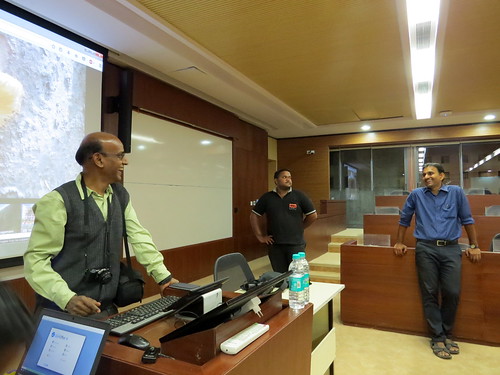On Dec. 23, 2016, I conducted a “Walk-n-Talk” for the residents of the campus at Indian Institute of Managament, Bangalore (IIMB).

Pic: Deepa Mohan
Prof Shainesh, who is the Dean of Administration, and a keen birder himself, opened up the campus for two bird census events in Feb and Nov 2016, and he wanted to ensure that the residents on the campus also got to know more about the flora and avifauna in the place where they live.

Group before setting off for the walk. Pic: Deepa Mohan
Dr. Selvarajan Rajeswaran, who is doing a doctoral program at IIMB, was extremely helpful, and Darshan H N, the photographer who has been documenting birds and flowers at IIMB, agreed to provide some images for the talk. However, my focus was mainly the walk, as I find that people are far more interested in what they can see, hear, touch (yes, there was some tasting too!) and experience through all their senses in the field. The talk, however, would serve to reinforce what they experienced on the walk. My friends Aravind A M (who is an alumnus of IIMB himself) and Ajit Ampalakkad very kindly agreed to help me out with the walk. About 40 people joined us at about 4.30pm in the evening, and we walked around the campus. Here’s the Ashy Drongo, which was one of the first birds we spotted:

Pic: Deepa Mohan
We also saw this female Asian Koel, and several other birds.

Asian Koel. Pic: Deepa Mohan
Ajit pointed out several trees and plants and gave us interesting information about them. For example, in the photo below, he talks about Bixa orellana, the “lipstick” plant, and how it produces a red dye. I couldn’t resist clicking some actual lipstick in the same shot!


Pic: Deepa Mohan
Aravind also spotted several birds as we walked, and talked about them

Pic: Deepa Mohan
The campus has a great range of flowering plants and trees, and I showed my fellow-walkers some beautiful ones, like this Passion Flower.

Pic: Deepa Mohan
We looked at some exotic plants such as this Traveller’s Palm.

Pic: Deepa Mohan
This beautiful Torch Ginger was something stunning to look at!

Pic: Deepa Mohan
The talk, in one of the classrooms, also went well, as the audience was very interactive.

Pic: Deepa Mohan
Here’s Dr Rajeswaran sharing a lighter moment with Ajit:
Aravind played the calls of some of the birds we’d seen, and which are quite common. Ajit then showed the audience how they can participate in, and contribute to, citizen science initiatives such as E-bird.

Pic: Deepa Mohan
A delicious dinner for all the participants was a great way to wind up the evening!
Related Articles
Birds leave the fashion to the males
The Great Backyard Bird Count
What to do if you (really) see a wild animal within Bengaluru city limits
Getting close to flowers
Nature walk at Puttenahalli lake in November
